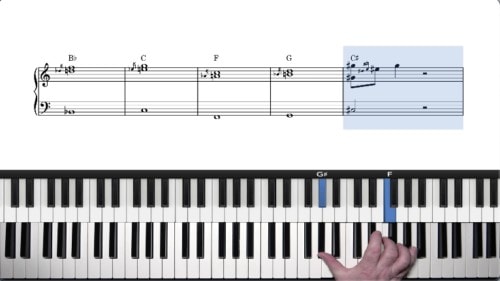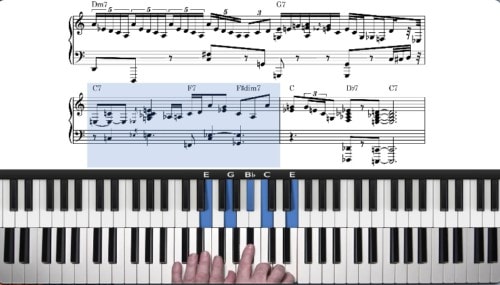The Major Blues Scale over "Georgia"
In this lesson we create a soulful arrangement for the tune "Georgia on my mind". The tune follows a 32 bar, A1-A2-B-A2 form. The A sections are major and then in the bridge the harmony switches to the relative minor.
Ray Charles’ performance of this tune has become the definitive recording but ‘Gerogia’ has also been recorded by many of the jazz greats such as Oscar Peterson and Louis Armstrong and Wes Montgomery.
In part 1 we play through the form with some simple voicings so we understand the harmonic movement and the chords that we will come across. We then introduce the major blues scale concept which can be used to improvise over major chords, dominant chords, and entire major 251 progressions.
In part 2 we then play through again adding more complex voicings, passing chords and some bluesy and soulful licks and lines.
Practice Tips
-
Learn and memorise the major blues scale. Work on 2-3 keys at a time.
-
Armed with your knowledge of the major and extended blues scales, listen and transcribe from your favourite players.
-
If you have tried transcribing blues in the past you may have found it difficult because you were only aware of the minor blues scale.
- If we listen to any bluesy soloists - Oscar Peterson or Gene Harris are two great example for piano - we will hear that they use a lot of major blues scale which unlocks these other important notes.







This was great lesson. Explanation of major blues scale and relation to minor is so useful
Thanks Michael. I’m glad you enjoyed it! Make sure to listen to players such as Oscar Peterson and Gene Harris to hear how they use the blues scale and it’s major variation.
We will be looking at this in more details with some tutorials on the blues form.
Cheers,
Hayden
great lesson. Much slower would be appreciated for us beginners!
Thanks for letting me know Ronny… I’ll keep that in mind for future tutorials :-)
Cheers,
Hayden
It would be super helpful to add chord charts with the appropriate voicing as an additional worksheet
Hi Omer,
Thanks for this suggestion.
The chord chart download contains the chord symbol and harmony, and the transcription download contains the exact voicings played.
Do you mean to create a combination of the chord chart and the transcription download into 1 document.
Let me know how you think it would work best.
Cheers,
Hayden
Wow – that just blew me away haha! SOOOO good. Thanks so much for this SUPERB lesson Hayden. :)
Hi Hayden, Wonderful to have these lessons!
I’m brand new here and maybe jumped in above my level.
I had been working on the ballad Georgia. And am eager to learn more interesting voicings and embellishments. However, I think need exercises to learn/drill the voicings you are using with such facility.
Would you kindly make recommendations.
Sincerest thanks, Nancy
Hi Nancy,
Thanks for the message.
For learning the tune Georgia, I would recommend starting with this course:
pianogroove.com/jazz-piano-lessons/bluesy-stride-piano-beginners/
In the first 3 lessons we cover the following topics:
– Diatonic 7th Chords in F Major
– Basic Spread Voicings
– Stride Left Hand Style
Check out those 3 lessons and you will see that I show different drills using the harmony of the tune. Ultimately the key is lots of repetition playing through the A Section and the voicings options and harmony will become more comfortable to you.
This does take time so do be patient with it, and once you are comfortable with the basics you can progress onto the next lessons in the course.
I hope that helps Nancy, and let me know if you have any further questions.
Cheers,
Hayden